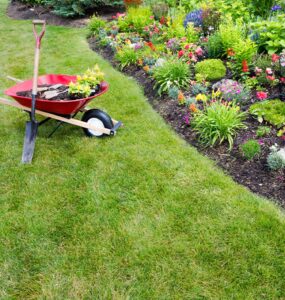Getting your Garden Ready to Grow: Spring Rejuvenation made Easy
by Rob Sproule
April is the most idealistic month, when gardeners’ fancies turn lightly to thoughts of ripening tomatoes sweet peas climbing. It’s also the ugliest month, the muddy brown stretch between winter and spring, when warm days tease and cold snaps terrify.
Receding snow can be brutally honest, and rarely reveals black, rich garden beds ready to be sown into. More often it exposes soil that is either too muddy or too depleted (ie. dusty) to grow the blue ribbon veggies.
Drainage
The importance of healthy dirt doesn’t get quite as much coverage in the glossy magazine as the latest tea rose or the hottest new pepper. But it’s hard to have a healthy root system without healthy soil, and it’s impossible to have a blooming, fruiting plant without good roots.
Good drainage is about finding the balance between having good drainage and keeping enough nutrient rich medium at root level. The science to testing your garden’s drainage is in the palm of your hand.
Grab a handful of moist (but not wet) soil and squeeze it tight. If the clump holds loosely together as you open your hand, but crumbles with a jabbed fingertip, you happily have Goldilocks soil (neither too much sand or too much clay, but just the right amount of loam). If this isn’t your soil, make it your goal.
Too Sandy
If the clump of soil falls apart instantly when your hand opens, your soil is too sandy. This means that your garden’s drainage is too good, and if you dig a 6″ hole and fill it with water, it will probably drain right away.
Even a healthy garden plot, if not annually amended, will eventually turn dusty. This is because essential nutrients like nitrogen and potassium, which edibles need in abundance, are depleted by natural draining (they’re water soluble) and hungry, hungry edibles like corn.
Amending sandy soil is fairy easy. Measure the size of the garden space that needs work (get an idea of how many square meters it contains).
Head to the Garden Centre and grab 1 40 litre bag of compost (no significant difference between sheep and steer) or Sea Soil (my favourite) for every square meter of ground. 1 bag per square meter will give you a 4-5 cm layer, which is ideal for annual touch-ups. If your garden looks like a Grapes of Wrath style dustbowl, double it to an 8-10 cm layer.
With a full size shovel or pitch fork, blend the layers evenly together. If using a roto-tiller make sure the blades are deep enough.
Too Much Clay
If you open your hand and your clump or soil is as tight as a golf ball, you’ve got clay. Don’t worry, you’re far from alone in this. While clay based soils retains nutrients, it stays soggy and is usually so dense that young, fibrous roots can’t grow into it.
While amending sandy soils is about adding nutrient retention, amending clay is all about opening the pores for delicate roots to be able to breath. Head to the Garden Center and look for the peat moss.
Peat moss bags are compressed, so one bag goes a long way. It’s also the most affordable garden amendment. Unless your clay based garden still contains ample black loam/earth, you’ll still need some compost as peat moss is for improving drainage only and contains very few nutrients.
















